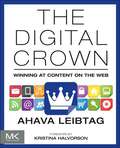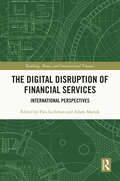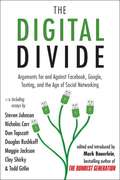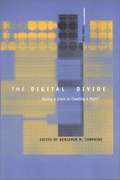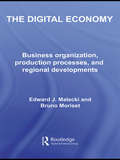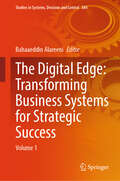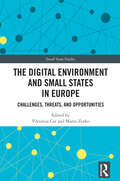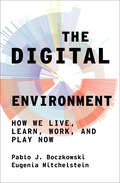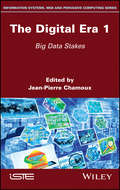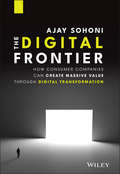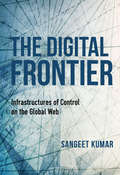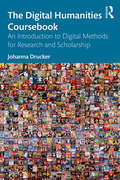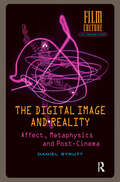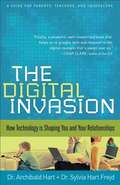- Table View
- List View
The Digital Crown: Winning at Content on the Web
by Ahava LeibtagThe Digital Crown walks you through the essentials of crafting great content: the fundamentals of branding, messaging, business goal alignment, and creating portable, mobile content that is future-ready. Systems create freedom, and within this book you’ll learn the seven critical rules to align your internal and external content processes, including putting your audience first, involving stakeholders early and often, and creating multidisciplinary content teams.
The Digital Darkroom: The Definitive Guide to Photo Editing
by James AbbottPost-production can make the difference between a good image and a great image, not to mention it's an essential process if you shoot in RAW to enjoy the most flexibility and control possible. This book will outline everything you need to know to gain a better understanding of how to apply darkroom style effects to your images using Adobe Photoshop and Affinity Photo.Through detailed background knowledge designed to make you familiar with the software and to build your confidence, you'll learn a wide range of skills and techniques through step-by-step case studies that will make learning an active experience. Not only will this be a valuable reference resource, it will also be your very own personal tutor giving you everything you need to edit your images like a pro. - Learn the essentials with a complete guide to every tool, filter and effect for both Adobe Photoshop and Affinity Photo- Get the most out of your RAW files with detailed instructions on processing your digital image- Master basic, intermediate, and advanced editing techniques with easy to follow step-by-step tutorials- Get the best quality images for display with a complete guide to home printing
The Digital Darkroom: The Definitive Guide to Photo Editing
by James AbbottPost-production can make the difference between a good image and a great image, not to mention it's an essential process if you shoot in RAW to enjoy the most flexibility and control possible. This book will outline everything you need to know to gain a better understanding of how to apply darkroom style effects to your images using Adobe Photoshop and Affinity Photo.Through detailed background knowledge designed to make you familiar with the software and to build your confidence, you'll learn a wide range of skills and techniques through step-by-step case studies that will make learning an active experience. Not only will this be a valuable reference resource, it will also be your very own personal tutor giving you everything you need to edit your images like a pro. - Learn the essentials with a complete guide to every tool, filter and effect for both Adobe Photoshop and Affinity Photo- Get the most out of your RAW files with detailed instructions on processing your digital image- Master basic, intermediate, and advanced editing techniques with easy to follow step-by-step tutorials- Get the best quality images for display with a complete guide to home printing
The Digital Dialectic: New Essays On New Media
by Peter LunenfeldComputers linked to networks have created the first broadly used systems that allow individuals to create, distribute, and receive audiovisual content with the same box. They challenge theorists of digital culture to develop interaction-based models to replace the more primitive models that allow only passive use. The Digital Dialectic is an interdisciplinary jam session about our visual and intellectual cultures as the computer recodes technologies, media, and art forms. Unlike purely academic texts on new media, the book includes contributions by scholars, artists, and entrepreneurs, who combine theoretical investigations with hands-on analysis of the possibilities (and limitations) of new technology. The key concept is the digital dialectic: a method to ground the insights of theory in the constraints of practice. The essays move beyond journalistic reportage and hype into serious but accessible discussion of new technologies, new media, and new cultural forms.
The Digital Disruption of Financial Services: International Perspectives (Banking, Money and International Finance)
by Ewa LechmanThis book contributes to the present state of knowledge, offering the reader broad evidence on how new digital technologies impact financial systems. It focuses on both macro- and micro-perspectives of ICT influence on financial markets. The book demonstrates how ICT can impact trading systems or information systems, which are crucial for financial systems to work effectively. It also shows how individuals can benefit from the adoption of digital technologies for everyday financial (e.g., banking) systems usage. The book provides empirical evidence of how digital technologies revolutionize the banking sector and stock exchange trading system and explores the associations between technology and various aspects of firms’ functioning. Furthermore, it raises elements of financial inclusion, ICT-based microfinance service and finance-related gender issues. The principal audience of the book will be scholars and academic professionals from a wide variety of disciplines, particularly in the fields of finance and economics. It will be especially useful for those who are addressing the issues of new technologies and the financial markets, FinTech, financial innovations, stock markets, and the role of technological progress in a broadly defined socio-economic system. It will be a valuable source of knowledge for graduate and postgraduate students in economic and social development, information and technology, worldwide studies, social policy or comparative economics.
The Digital Divide
by Mark BauerleinThis definitive work on the perils and promise of the social-media revolution collects writings by today's best thinkers and cultural commentators, with an all-new introduction by Bauerlein. Twitter, Facebook, e-publishing, blogs, distance-learning and other social media raise some of the most divisive cultural questions of our time. Some see the technological breakthroughs we live with as hopeful and democratic new steps in education, information gathering, and human progress. But others are deeply concerned by the eroding of civility online, declining reading habits, withering attention spans, and the treacherous effects of 24/7 peer pressure on our young. With The Dumbest Generation, Mark Bauerlein emerged as the foremost voice against the development of an overwhelming digital social culture. But The Digital Divide doesn't take sides. Framing the discussion so that leading voices from across the spectrum, supporters and detractors alike, have the opportunity to weigh in on the profound issues raised by the new media-from questions of reading skills and attention span, to cyber-bullying and the digital playground- Bauerlein's new book takes the debate to a higher ground. The book includes essays by Steven Johnson, Nicholas Carr, Don Tapscott, Douglas Rushkoff, Maggie Jackson, Clay Shirky, Todd Gitlin, and many more. Though these pieces have been previously published, the organization of The Digital Dividegives them freshness and new relevancy, making them part of a single document readers can use to truly get a handle on online privacy, the perils of a plugged-in childhood, and other technology-related hot topics. Rather than dividing the book into "pro" and "con" sections, the essays are arranged by subject-"The Brain, the Senses," "Learning in and out of the Classroom," "Social and Personal Life," "The Millennials," "The Fate of Culture," and "The Human (and Political) Impact." Bauerlein incorporates a short headnote and a capsule bio about each contributor, as well as relevant contextual information about the source of the selection. Bauerlein also provides a new introduction that traces the development of the debate, from the initial Digital Age zeal, to a wave of skepticism, and to a third stage of reflection that wavers between criticism and endorsement. Enthusiasms for the Digital Age has cooled with the passage of time and the piling up of real-life examples that prove the risks of an online-focused culture. However, there is still much debate, comprising thousands of commentaries and hundreds of books, about how these technologies are rewriting our futures. Now, with this timely and definitive volume, readers can finally cut through the clamor, read the the very best writings from each side of The Digital Divide, and make more informed decisions about the presence and place of technology in their lives.
The Digital Divide
by Mark BauerleinThis definitive work on the perils and promise of the social- media revolution collects writings by today's best thinkers and cultural commentators, with an all-new introduction by Bauerlein. Twitter, Facebook, e-publishing, blogs, distance-learning and other social media raise some of the most divisive cultural questions of our time. Some see the technological breakthroughs we live with as hopeful and democratic new steps in education, information gathering, and human progress. But others are deeply concerned by the eroding of civility online, declining reading habits, withering attention spans, and the treacherous effects of 24/7 peer pressure on our young. With The Dumbest Generation, Mark Bauerlein emerged as the foremost voice against the development of an overwhelming digital social culture. But The Digital Divide doesn't take sides. Framing the discussion so that leading voices from across the spectrum, supporters and detractors alike, have the opportunity to weigh in on the profound issues raised by the new media-from questions of reading skills and attention span, to cyber-bullying and the digital playground- Bauerlein's new book takes the debate to a higher ground. The book includes essays by Steven Johnson, Nicholas Carr, Don Tapscott, Douglas Rushkoff, Maggie Jackson, Clay Shirky, Todd Gitlin, and many more. Though these pieces have been previously published, the organization of The Digital Divide gives them freshness and new relevancy, making them part of a single document readers can use to truly get a handle on online privacy, the perils of a plugged-in childhood, and other technology-related hot topics. Rather than dividing the book into "pro" and "con" sections, the essays are arranged by subject-"The Brain, the Senses," "Learning in and out of the Classroom," "Social and Personal Life," "The Millennials," "The Fate of Culture," and "The Human (and Political) Impact. " Bauerlein incorporates a short headnote and a capsule bio about each contributor, as well as relevant contextual information about the source of the selection. Bauerlein also provides a new introduction that traces the development of the debate, from the initial Digital Age zeal, to a wave of skepticism, and to a third stage of reflection that wavers between criticism and endorsement. Enthusiasms for the Digital Age has cooled with the passage of time and the piling up of real-life examples that prove the risks of an online-focused culture. However, there is still much debate, comprising thousands of commentaries and hundreds of books, about how these technologies are rewriting our futures. Now, with this timely and definitive volume, readers can finally cut through the clamor, read the the very best writings from each side of The Digital Divide, and make more informed decisions about the presence and place of technology in their lives. .
The Digital Divide: Facing a Crisis or Creating a Myth?
by Benjamin M. CompaineThe Digital Divide refers to the perceived gap between those who have access to the latest information technologies and those who do not. If we are indeed in an Information Age, then not having access to this information is an economic and social handicap. Some people consider the Digital Divide to be a national crisis, while others consider it an over-hyped nonissue. This book presents data supporting the existence of such a divide in the 1990s along racial, economic, ethnic, and education lines. But it also presents evidence that by 2000 the gaps are rapidly closing without substantive public policy initiatives and spending. Together, the contributions serve as a sourcebook on this controversial issue.
The Digital Divide: The Internet and Social Inequality in International Perspective (Routledge Advances in Sociology)
by Massimo Ragnedda Glenn W. MuschertThis book provides an in-depth comparative analysis of inequality and the stratification of the digital sphere. Grounded in classical sociological theories of inequality, as well as empirical evidence, this book defines ‘the digital divide’ as the unequal access and utility of internet communications technologies and explores how it has the potential to replicate existing social inequalities, as well as create new forms of stratification. The Digital Divide examines how various demographic and socio-economic factors including income, education, age and gender, as well as infrastructure, products and services affect how the internet is used and accessed. Comprised of six parts, the first section examines theories of the digital divide, and then looks in turn at: Highly developed nations and regions (including the USA, the EU and Japan); Emerging large powers (Brazil, China, India, Russia); Eastern European countries (Estonia, Romania, Serbia); Arab and Middle Eastern nations (Egypt, Iran, Israel); Under-studied areas (East and Central Asia, Latin America, and sub-Saharan Africa). Providing an interwoven analysis of the international inequalities in internet usage and access, this important work offers a comprehensive approach to studying the digital divide around the globe. It is an important resource for academic and students in sociology, social policy, communication studies, media studies and all those interested in the questions and issues around social inequality.
The Digital Dividend of Terrestrial Broadcasting
by Roland BeutlerThe "digital revolution" of the last two decades has pervaded innumerable aspects of our daily lives and changed our planet irreversibly. The shift from analog to digital broadcasting has facilitated a seemingly infinite variety of new applications--audience interactivity being but one example. The greater efficiency and compression of digital media have endowed broadcasters with a "digital dividend" of spare transmission capacity over and above the requirements of terrestrial broadcasting. The question is, who will use it, and how? Comparing the European experience with that of broadcasters elsewhere in the world, the author sketches the current status of international frequency management, quantifies the value of the "dividend" itself, analyzes the details of the analog-to-digital switchovers already completed, and posits what the future holds for the sector. As we grapple with new devices, inconceivable a mere generation ago, that allow us to access digital media instantly, anywhere and at any time of day, this book is a potent reminder that what we have witnessed so far may be just the first wavering steps along a road whose destination we can only guess at.
The Digital Economy: Business Organization, Production Processes and Regional Developments
by Edward J. Malecki Bruno MorisetInformation technologies (IT) shape economic space, but we have no clear map of the cyber economy since the "digital revolution" began in the early 1970s. The Digital Economy offers an up-to-date, critical synthesis that links the various aspects of the digital or cyber economy from the perspective of real firms. A geographic approach emphasizes how IT has made businesses less dependent on locational constraints, and the tangible effects on places and regions are placed at the core of the analysis. Case studies of companies, including Amazon, Dell, Li & Fung, and Volvo, demonstrate that the geography of digitally-driven production is the outcome of both dispersion and agglomeration dynamics. Global corporations are shown to have footprints that ignore – to some degree – distance and time, yet creative and coordinating activities remain anchored in urban innovative ecosystems such as Silicon Valley and Bangalore. These trends have been made possible by the development of a worldwide and integrated telecommunications network, whose unequal presence dictates the capabilities of places and communities to be connected to the global economy. However, the threat of the digital divide must not be overstated. In cities, rural areas, and emerging countries, local development is wrapped up in human capital, rather than technology. This engaging and accessible text describes and explains the patterns and dynamics of today’s digital economic space. The effects on places and regions and the people in them are at the core of the authors’ analysis, illustrated by many real examples. This book will be useful to anyone studying business and management, geography and information and communication studies.
The Digital Edge: Volume 1 (Studies in Systems, Decision and Control #584)
by Bahaaeddin AlareeniThis book aims to provide a comprehensive examination, analysis, and reflection on digitalization strategies, technologies, and management practices that drive successful digital transformation, in addition to the challenges encountered. Digital transformation is fundamentally transforming the landscape of business systems, driving innovation and efficiency within businesses. This book aims to provide a comprehensive examination, analysis, and reflection on digitalization strategies, technologies, and management practices that drive successful digital transformation, in addition to the challenges encountered. Topics included are cloud computing, Bbig Ddata analytics, Internet of Things (IoT), robotic process automation (RPA), and digital twin technology. This book will also addresses the leadership strategies, organizational culture, and change management process necessary to facilitate digital transformation. Case studies across industries will highlight successful digital transformation efforts and common pitfalls. This book is designed for business leaders, managers, and researchers interested in leveraging digital transformation for sustained competitive advantage.
The Digital Environment and Small States in Europe: Challenges, Threats, and Opportunities (Small State Studies)
by Viktorija Car Marta ZorkoThe Digital Environment and Small States in Europe delves into how the digital revolution intersects with global security dynamics and reshapes the geopolitical landscape. It sheds light on the geopolitical complexities inherent in the border regions of the European continent and proposes frameworks to better understand and engage with small state dynamics in international affairs.At the heart of this book is an examination of the transformative power of digitalization and virtualization, particularly pronounced in the context of small states. Traditionally, power was synonymous with territorial control, but in today’s world, influence extends into the virtual realm. Small states, despite their physical limitations, can leverage this virtual extension of territory to their advantage. However, realizing and strategically utilizing these advantages are essential for capitalizing on the opportunities presented. Conversely, small states lacking digital capabilities find themselves increasingly vulnerable in the virtual sphere, facing heightened security threats and challenges. Through a series of theoretical and case study-based chapters, this book offers insights into the strategies employed by small states to navigate these complexities and assert their influence on the global stage. Key themes explored include the impact of digitalization on geopolitical dynamics, the role of cybersecurity in safeguarding national interests, and the emergence of digital diplomacy as a tool for statecraft.The Digital Environment and Small States in Europe will be of great interest to scholars and students of international relations, geopolitics, and political science, as well as security, media, and communication studies. Additionally, policymakers and analysts involved in foreign policy and security affairs may find valuable insights in the book’s exploration of small state strategies and vulnerabilities.
The Digital Environment: How We Live, Learn, Work, and Play Now
by Pablo J. Boczkowski Eugenia MitchelsteinUnderstanding digital technology in daily life: why we should think holistically in terms of a digital environment instead of discrete devices and apps.Increasingly we live through our personal screens; we work, play, socialize, and learn digitally. The shift to remote everything during the pandemic was another step in a decades-long march toward the digitization of everyday life made possible by innovations in media, information, and communication technology. In The Digital Environment, Pablo Boczkowski and Eugenia Mitchelstein offer a new way to understand the role of the digital in our daily lives, calling on us to turn our attention from our discrete devices and apps to the array of artifacts and practices that make up the digital environment that envelops every aspect of our social experience. Boczkowski and Mitchelstein explore a series of issues raised by the digital takeover of everyday life, drawing on interviews with a variety of experts. They show how existing inequities of gender, race, ethnicity, education, and class are baked into the design and deployment of technology, and describe emancipatory practices that counter this--including the use of Twitter as a platform for activism through such hashtags as #BlackLivesMatter and #MeToo. They discuss the digitization of parenting, schooling, and dating--noting, among other things, that today we can both begin and end relationships online. They describe how digital media shape our consumption of sports, entertainment, and news, and consider the dynamics of political campaigns, disinformation, and social activism. Finally, they report on developments in three areas that will be key to our digital future: data science, virtual reality, and space exploration.
The Digital Era 1: Big Data Stakes
by Jean-Pierre ChamouxFor 200 years, industry mastered iron, fire, strength and energy. Today, electronics shapes our everyday objects, integrating chips: computers, phones, keys, games, household appliances, etc. Data, software and calculation frame the conduct of humankind, and everything is translated into data. The first volume in this series analyzes the stakes of the massive data which accumulate on the Internet, keeping track of our actions and gestures, the state of the world and our knowledge.
The Digital Filmmaking Handbook
by Chris Jones Mark BrindlePart of the perennially best-selling Quercus Digital Photography series, this comprehensive guide features everything you need to know to make a digital film, from conception to finished product. Using clear, step-by-step instruction, The Digital Filmmaking Handbook concisely illustrates the technical and creative challenges of digital filmmaking for novices and professionals alike, spanning topics from conception to execution: - Planning a shoot: how to make a storyboard - Set preparation: dressing and lighting a set - Principal photography: filming with HD and DSLR cameras--including the latest advice on equipment, accessories, and software - Advanced editing: software and practices - Post-production: digital effects and Packed with tips and tricks to develop both your creative vision and your technical know-how, The Digital Filmmaking Handbook is the ultimate resource for all your filmmaking needs. From the Trade Paperback edition.
The Digital Frontier: How Consumer Companies Can Create Massive Value Through Digital Transformation
by Ajay SohoniDiscover how to move forward with your own company’s digital transformation with this accessible new resource from a global leader in his field In The Digital Frontier, experienced executive and distinguished author Ajay Sohoni delivers a relatable and readable reference for corporate executives who need the knowledge and confidence to build lasting digital change within their enterprise. From marketing to commercial, supply chain, and finance, the book offers actionable insights in an accessible format, full of anecdotes, humor, and case examples. You’ll learn which areas to focus on and which not to worry about as you craft your own custom transformation journey. In the book, you’ll also find: A demystification of the startup world for executives and an explanation of why unicorns exist (and so often ultimately fail) A detailed description of the digital transformation gripping companies across a variety of industries in functional areas including advertising, engagement, commerce, product development, manufacturing, and corporate functions A simplified 4-stage framework for companies to start from scratch and build valuable use cases Perfect for executives in consumer-facing companies, corporate managers and leaders, business unit heads and management teams, The Digital Frontier is also an indispensable guide for digital non-natives trying to make sense of, and keep up with, the rapidly changing world around them.
The Digital Frontier: Infrastructures of Control on the Global Web (Framing the Global)
by Sangeet KumarThe global web and its digital ecosystem can be seen as tools of emancipation, communication, and spreading knowledge or as means of control, fueled by capitalism, surveillance, and geopolitics.The Digital Frontier interrogates the world wide web and the digital ecosystem it has spawned to reveal how their conventions, protocols, standards, and algorithmic regulations represent a novel form of global power. Sangeet Kumar shows the operation of this power through the web's "infrastructures of control" visible at sites where the universalizing imperatives of the web run up against local values, norms, and cultures. These include how the idea of the "global common good" is used as a ruse by digital oligopolies to expand their private enclosures, how seemingly collaborative spaces can simultaneously be exclusionary as they regulate legitimate knowledge, how selfhood is being redefined online along Eurocentric ideals, and how the web's political challenge is felt differentially by sovereign nation states. In analyzing this new modality of cultural power in the global digital ecosystem, The Digital Frontier is an important read for scholars, activists, academics and students inspired by the utopian dream of a truly representative global digital network.
The Digital Gaming Handbook
by Roberto DillonThe Digital Gaming Handbook covers the state-of-the-art in video and digital game research and development, from traditional to emerging elements of gaming across multiple disciplines. Chapters are presented with applicability across all gaming platforms over a broad range of topics, from game content creation through gameplay at a level accessible for the professional game developer while being deep enough to provide a valuable reference of the state-of-the-art research in this field. Key Features: International experts share their research and experience in game development and design Provides readers with inside perspectives on the cross-disciplinary aspects of the industry Includes retrospective and forward-looking examinations of gaming Editor: Dr. Roberto Dillon is a leading game studies educator with more than 15 years of experience in the field of game design and development.
The Digital Humanities
by Gardiner, Eileen and Musto, Ronald G. Eileen Gardiner Ronald G. MustoThe Digital Humanities is a comprehensive introduction and practical guide to how humanists use the digital to conduct research, organize materials, analyze, and publish findings. It summarizes the turn toward the digital that is reinventing every aspect of the humanities among scholars, libraries, publishers, administrators, and the public. Beginning with some definitions and a brief historical survey of the humanities, the book examines how humanists work, what they study, and how humanists and their research have been impacted by the digital and how, in turn, they shape it. It surveys digital humanities tools and their functions, the digital humanists' environments, and the outcomes and reception of their work. The book pays particular attention to both theoretical underpinnings and practical considerations for embarking on digital humanities projects. It places the digital humanities firmly within the historical traditions of the humanities and in the contexts of current academic and scholarly life.
The Digital Humanities Coursebook: An Introduction to Digital Methods for Research and Scholarship
by Johanna DruckerThe Digital Humanities Coursebook provides critical frameworks for the application of digital humanities tools and platforms, which have become an integral part of work across a wide range of disciplines. Written by an expert with twenty years of experience in this field, the book is focused on the principles and fundamental concepts for application, rather than on specific tools or platforms. Each chapter contains examples of projects, tools, or platforms that demonstrate these principles in action. The book is structured to complement courses on digital humanities and provides a series of modules, each of which is organized around a set of concerns and topics, thought experiments and questions, as well as specific discussions of the ways in which tools and platforms work. The book covers a wide range of topics and clearly details how to integrate the acquisition of expertise in data, metadata, classification, interface, visualization, network analysis, topic modeling, data mining, mapping, and web presentation with issues in intellectual property, sustainability, privacy, and the ethical use of information. Written in an accessible and engaging manner, The Digital Humanities Coursebook will be a useful guide for anyone teaching or studying a course in the areas of digital humanities, library and information science, English, or computer science. The book will provide a framework for direct engagement with digital humanities and, as such, should be of interest to others working across the humanities as well.
The Digital Humanities Coursebook: Applied Concepts and Critical Approaches
by Johanna Drucker Francesca AlbrezziThis second edition of The Digital Humanities Coursebook provides critical frameworks for the application of digital humanities tools and platforms, which have become an integral part of work across a wide range of disciplines. This fully updated edition adds several new topics, including XR (extended reality) and AI (artificial intelligence), as well as a companion website developed in parallel with the chapters and providing extended ''how-to'' examples to enable students and teachers to follow step-by-step demonstrations of tools or platforms.Written in an accessible and engaging manner, this book is focused on the principles and fundamental concepts for application and each chapter contains case study examples of projects, tools and platforms that demonstrate these principles in action. This book clearly details how to integrate the acquisition of expertise in data, metadata, classification, interface, visualization, network analysis, topic modeling, data mining, mapping, and web presentation with issues in intellectual property, sustainability, privacy, and the ethical use of information. By combining practical information and critical issues, the book demonstrates that no application of digital humanities can be separated from ethical and critical concerns.This book is structured to complement courses on digital humanities and provides a series of modules, each of which is organized around a set of concerns and topics, thought experiments and questions, as well as discussions of the ways in which tools and platforms work. Each chapter contains an introduction to the topic, examples of current (and sometimes classic) work being done in the field, a set of exercises to explore the hands-on experience, references, and recommended readings. The Digital Humanities Coursebook will therefore be an indispensable guide for anyone teaching or studying a course in the areas of digital humanities, library and information science, English, or computer science.
The Digital Image and Reality: Affect, Metaphysics and Post-Cinema (Film Culture in Transition)
by Daniel StruttThe media technologies that surround and suffuse our everyday life profoundly affect our relation to reality. Philosophers since Plato and Aristotle have sought to understand the complex influence of apparently simple tools of expression on our understanding and experience of the world, time, space, materiality and energy. The Digital Image and Reality takes up this crucial philosophical task for our digital era. This rich yet accessible work argues that when new visual technologies arrive to represent and simulate reality, they give rise to nothing less than a radically different sensual image of the world. Through engaging with post-cinematic content and the new digital formats in which it appears, Strutt uncovers and explores how digital image-making is integral to emergent modes of metaphysical reflection - to speculative futurism, optimistic nihilism, and ethical plasticity. Ultimately, he prompts the reader to ask whether the impact of digital image processes might go even beyond our subjective consciousness of reality, towards the synthesis of objective actuality itself.
The Digital Interface and New Media Art Installations (Routledge Advances in Art and Visual Studies)
by Phaedra ShanbaumThis book is about the digital interface and its use in interactive new media art installations. It examines the aesthetic aspects of the interface through a theoretical exploration of new media artists, who create, and tactically deploy, digital interfaces in their work in order to question the socio-cultural stakes of a technology that shapes and reshapes relationships between humans and non-humans. In this way, it shows how use of the digital interface provides us with a critical framework for understanding our relationship with technology.
The Digital Invasion: How Technology Is Shaping You and Your Relationships
by Archibald D. Hart Sylvia Hart FrejdIn the world of technology, there are just two kinds of people: digital natives and digital immigrants. Digital natives are those born after the advent of the internet. They are comfortable with swift technological change and take the presence of technology in their lives almost completely for granted. They have "digital DNA" flowing through their bodies. On the other hand, digital immigrants are those born before the advent of the internet. Their comfort level with our technology-soaked world is more variable. But they are affected by the digital invasion just as much as their native children. With the latest research supporting them, Dr. Archibald Hart and Dr. Sylvia Hart Frejd uncover both the subtle and the dramatic ways digital technology is changing us from within, focusing their exposé on the impact on the spiritual life of individuals. Through insights from neuroscience and psychology, they offer readers therapeutic and biblical strategies for handling the digital invasion in order to become good stewards of their digital lives. Parents, educators, students, counselors, and pastors will especially appreciate this cultural wake-up call. Much of the focus is from a Christianity perspective, but a lot of good information about what use of technology (especially excessive addictive) does to the brain and our ability to function
